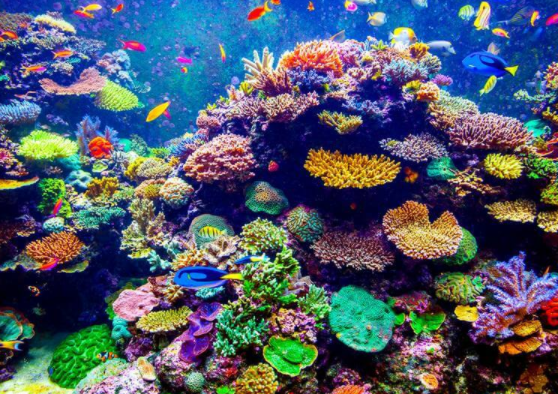And it all starts with just one tiny coral colony.
这一切都始于微小的珊瑚群落。
So much life in the tropical oceans depends on coral reefs.
热带海洋中的许多生物都依赖于珊瑚礁。
Coral reefs can grow quite large.
珊瑚礁可以长得很大。
The largest one in the world is the Great Barrier Reef off northeastern Australia, which is over 1500 miles long!
世界上最大的珊瑚礁是澳大利亚东北部的大堡礁,长度可达1500多英里!
It's so big it can be seen from space!
它太大了,从空中都能看到!
Coral reefs live all around the world in tropical waters.
珊瑚礁生活在世界各地的热带水域。
They can't live in cold water because the coral is unable to create calcium carbonate if the water gets too cold.
它们不能生活在冷水中,因为如果海水太冷,珊瑚就不能产生碳酸钙。
Unfortunately, there is not much plankton in tropical water.
不幸的是,热带水域的浮游生物并不多。
That's why it's so nice and clear.
这就是为什么它这么好,这么清晰。
But at night, plankton comes up from cooler, deeper water and that's when the coral feeds.
但是在晚上,浮游生物从较冷、较深的水中浮上来,这是珊瑚的捕食时间。
Unfortunately, most of the time, coral still doesn't catch enough plankton to survive.
不幸的是,大多数时候,珊瑚仍然不能捕捉到足够的浮游生物来幸存。
So it has worked out a great partnership.
这是一个很好的合作关系。
Many corals have a greenish or brownish color because they have tiny microscopic algaecalled zooxanthellae living in their skin.
许多珊瑚呈绿色或褐色,因为它们的皮肤上生活着微小的藻类,我们称之为虫黄藻。
The zooxanthellae make energy from the sun's rays.
虫黄藻从太阳光获得能量。
In exchange for having a nice place to live in the skin of the coral, they share some of their energy with the coral.
它们与珊瑚分享能量以换取在珊瑚表皮上的好住处。
So the coral is partially solar powered.
所以珊瑚局部是由太阳能驱动的。
As long as they grow in nice shallow, sunlit water, solar powered corals don't need to catch much plankton.
只要生长在阳光充足的浅水中,太阳能珊瑚就不需要捕捉太多的浮游生物。
This is why reefs form in shallow water.
这就是珊瑚礁形成于浅水区的原因。
Sometimes I see coral that is turning white as if it's losing its color.
有时我看到珊瑚变白了,好像失去了颜色。

This is called bleaching.
这叫做漂白。
When corals are subjected to environmental stress, such as high or low water temperatures, changes in salinity or pH, siltation, or even just too much sun from a really low tide, they start to turn white.
当珊瑚受到环境压力时,例如水温的高低、盐度或pH值的变化、淤积,甚至是退潮时过多的阳光照射,就会开始变白。
This happens because the zooxanthellae starts to die.
这是因为虫黄藻开始死亡。
Since corals get their color from the zooxanthellae, when the zooxanthellae goes away, so does the color.
由于珊瑚的颜色来自于虫黄藻,当虫黄藻消失时,颜色也随之消失。
And if it goes on for too long, the coral dies because it needs the energy from the zooxanthellae.
如果持续太久,珊瑚就会死亡,因为它需要虫黄藻的能量。
Since most coral is as hard as a rock, very few animals can actually eat it.
由于大多数珊瑚像岩石一样坚硬,实际上很少有动物能食用珊瑚。
But a few can.
但也有少数动物可以食用。
The crown of thorns sea star dines on the outer skin of the coral.
棘冠星鱼在珊瑚的外壳上进食。
An outbreak of crown-of-thorns sea stars can wreak havoc on a reef.
棘冠星鱼的爆发会对珊瑚礁造成严重破坏。
All that remains of the coral after a crown-of-thorns attack is a dead white skeleton.
在棘冠星鱼攻击之后,珊瑚只剩下一具白色的死尸。
Parrotfish eat coral too.
鹦嘴鱼也以珊瑚为食。
They take big crunchy bites out of the reef, and grind up the calcium carbonate as they chew.
它们从珊瑚礁里咬出松脆的大块食物,咀嚼时把碳酸钙磨碎。
The parrotfish have a tough beak that's as hard as steel for biting the reef.
鹦嘴鱼的喙很硬,像钢铁一样坚硬,可以用来咬珊瑚礁。
And the hard particles that they excrete later end up as sand on the beach.
它们排出的硬颗粒后来变成了沙滩上的沙子。
It's true--tropical beaches are made partly of fish poop.
没错——热带海滩部分成分是由鱼粪构成的。
So the next time you are relaxing on a tropical beach or snorkeling in shallow water looking at the fish, you have coral to thank.
所以下次当你在热带沙滩上放松,或者在浅水区浮潜看鱼的时候,你要感谢珊瑚。
It's a very simple animal that can't walk or swim, can't see, and has no brain—but nearly all life in shallow tropical oceans depends on coral reefs.
珊瑚是一种非常简单的动物,不会走路或游泳,看不见东西,也没有大脑——但热带浅海中的几乎所有生命都依赖珊瑚礁。











